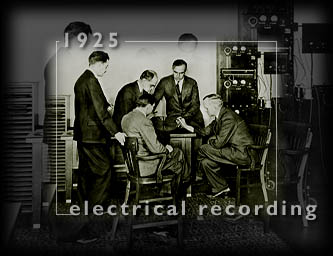

|
Recording
(830k Quicktime) Researchers fine-tune the recording process. |
![]()
IN THE BEGINNING...music was recorded when its sound waves struck a membrane that jiggled a needle that dug into a cylinder of wax or metal foil. That was mechanical recording - and it produced the "tinny" sound that we associate with very old records. That wasn't good enough for the engineers at AT&T, who thought that electricity could do a better job. Using microphones and vacuum tube amplifiers, they invented the world's first electrical recording studio. In the process they extended the reproducible sound range of records by more than an octave and dramatically improved their fidelity.
The recording industry adopted electrical recording in 1925. Digital recording took a little longer...
AT&T also pioneered stereo and the 33 1/3 RPM record.
[More information about electrical recording.]